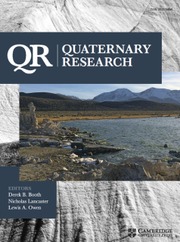Article contents
Late Quaternary glaciations in the Taniantaweng Mountains
Published online by Cambridge University Press: 13 November 2023
Abstract
Constraining the timing and extent of Quaternary glaciations in the Tibetan Plateau (TP) is significant for the reconstruction of paleoclimatic environment and understanding the interrelationships among climate, tectonics, and glacial systems. We investigated the late Quaternary glacial history of the Qinggulong and Juequ valleys in the Taniantaweng Mountains, southeastern TP, using cosmogenic 10Be surface exposure dating. Four major glacial events were identified based on 26 10Be ages. The exposure ages of the oldest late Quaternary glaciation correspond to Marine Oxygen Isotope Stage (MIS) 6. The maximum glacial extent was dated to 48.5–41.1 ka (MIS 3), during the last glaciation, and was more advanced than that of the last glacial maximum (LGM). Geochronology and geomorphological evidence indicate that multiple glacial fluctuations occurred in the study area during the Early–Middle Holocene. These glacial fluctuations likely were driven by the North Atlantic climate oscillations, summer solar insolation variability, Asian summer monsoon intensity, and CO2 concentration.
Keywords
- Type
- Thematic Set: Asian Climate
- Information
- Copyright
- Copyright © The Author(s), 2023. Published by Cambridge University Press on behalf of Quaternary Research Center
References
REFERENCES
- 2
- Cited by



